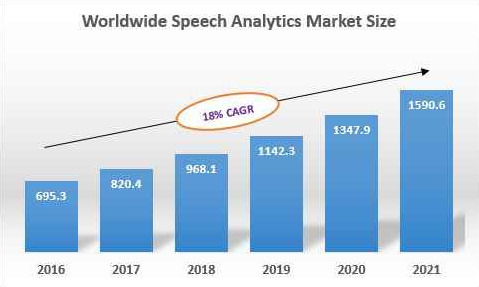What is Speech analytics? Speech analytics is the method of analyzing call recordings to collect vital customer sentiment and information to thereby enhance communication and further interactions. The process is mainly used by contact centers/call centers to extract information hidden in client interactions with agents.
Though speech analytics includes components of automatic speech recognition, it is well known for analyzing the topic being discussed, which is weighed against the sentiment associated with the speech and the amount and locations of speech versus non-speech during the interaction. Speech analytics in contact centers are also being utilized to mine recorded customer interactions to unearth the insights essential for drawing effective customer service and cost containment strategies.
The major uses of the analytics solution can be summarized as –
a. Root cause analysis: Understanding the reasons behind why people call.
b. Sentiment analysis: Understanding the callers’ sentiment whether it’s a positive, negative or a neutral one.
b. Trend analysis: Analyzing volume trends of both expected & unexpected call reasons behind customer calls to the contact center.
d. Call analysis: Evaluating caller and agent call duration, including holds, transfers etc.
e. Quality assurance: Monitoring how well call agents follow the scripts, understand customer thoughts and clearly communicate necessary information, or utter inappropriate words, make wrong transfers etc.
There are 3 kinds of Speech Analytics engines available in the market –
1. Phonetic
2. Speech-to-Phrase
3. Speech-to-Text
Speech analytics is one of the fastest growing segments of the contact center technology market, according to analysts and experts.
Speech technology delivers rapid & quantifiable benefits as enumerated below –
- Branding: Improving the brand value of a company and how it perceived in the market.
- Increased Productivity: As organization becomes more productive, there is reduction in operating costs.
- Operational Efficiency: Enhancing employees’ job performance thereby making the system more efficient.
- Enhanced Quality: Improving the products and services delivered by the company.
- CSAT: With the above enhancements, the customer will be more happy leading to greater customer satisfaction.
- Cost savings: Reduced costs by making the system more efficient, lesser training for agents, reduced repeat calls due to improved FCR, lower AHT making agents take more calls and also reduced number of call agents.
- Lower customer attrition: Identifying & lowering the number of at-risk customers.
- Increased revenue: Over time speech analytics helps increase revenue, thereby impacting topline and bottom-line positively.
The average payback timeframe for the application is 3 to 9 nine months, but results might vary across organizations. Organizations that already have in place processes that enable them to apply the insights from speech analytics technology on a frequent basis are realizing excellent returns. While, a good percentage of users are still struggling to apply the findings uncovered by speech analytics and, thus, are not reaping the true benefits of the solutions.
Market Sizing
The speech analytics market size is estimated to grow from USD 695.3 Million in 2016 to USD 1.59 Billion by 2021, at a Compound Annual Growth Rate (CAGR) of 18 .0% . Cloud based deployment model will show a faster growth rate compared to on-premise.
BPO/Outsourcing segment, Telecommunication and IT sectors will drive adoption.

Drivers and Challenges
With the growth in contact centers, rising need for CRM, competitive landscape are some of the key forces driving the speech analytics solution adoption. Also its cloud-based real-time speech analytics capability is also acting as a driver.
On the contrary, high initial cost of adoption, lack of awareness about the speech analytics technologies and its benefits are restraining the speech analytics market growth.
Competitive Landscape
Some of the important players in this space include Verint Systems, Genesys, NICE Systems, Interactive Intelligence Group, inContact, Calabrio, CallMiner, Avaya, Voci Technologies and ClaraBridge, along with others.
Final Thoughts
Today, across organizations, data that remains highly untapped is the information exchanged during verbal interactions. Speech Analytics solution does the job of collecting data and providing actionable insight on those interactions to the management. Relating analysis across various activities provides the opportunity to improve end-to-end experiences of the caller.
Technology is rapidly changing, we are observing a rapid shift of organization’s towards growing interest in multichannel analytics. Calls, text messages, emails, Twitter, Facebook, blogs, and other forms of social media are enhancing the visibility of speech analytics beyond contact center boundaries. Either way, Speech Analytics solutions help increase the efficiency and effectiveness of customer service through VOC programs, support compliance requirements, and expand BI.
Article by channel:
Everything you need to know about Digital Transformation
The best articles, news and events direct to your inbox
Read more articles tagged: Analytics, Featured, Marketing Analytics







